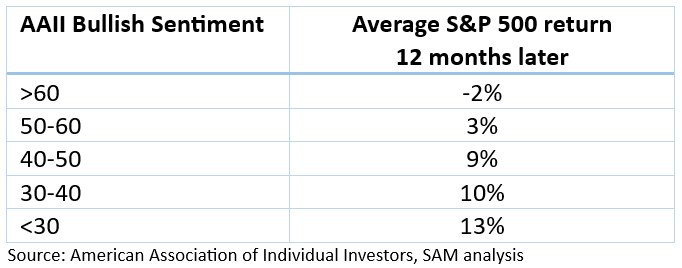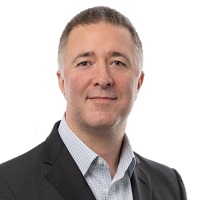(A Little) Greed Is Good When It Comes to Investing
Investors seem to feel only a little greedier than usual right now, and when investors feel that way, there are usually positive stock market returns ahead.


There’s a certain appeal to being a contrarian investor. Zigging when others are zagging. Going against the herd. And when you’re proven right, it feels pretty darn good (and can pay off handsomely).
One of the first adages contrarian investors learn comes from Warren Buffett. In his 1986 letter to Berkshire Hathaway shareholders, Buffett wrote about being fearful when others are greedy, and greedy when others are fearful.
Such moments are easy to recall. Maybe you bought Bitcoin near its 2021 top, when fear of missing out (FOMO) was in full swing. Or you saw a huge opportunity to buy stocks in March 2020, during the COVID crash … but couldn’t bring yourself to pull the trigger.
From just $107.88 $24.99 for Kiplinger Personal Finance
Become a smarter, better informed investor. Subscribe from just $107.88 $24.99, plus get up to 4 Special Issues

Sign up for Kiplinger’s Free Newsletters
Profit and prosper with the best of expert advice on investing, taxes, retirement, personal finance and more - straight to your e-mail.
Profit and prosper with the best of expert advice - straight to your e-mail.
Those tops and bottoms burn into our memories. But when it comes to investing around them, there’s a problem: They are rare.
It’s been nearly 36 years since 1987’s Black Monday stock market crash. From that time period up until today, the United States has had five bull and bear market cycles. That means 10 days of tops and bottoms. Over 36 years.
How are we to invest the rest of the time?
It turns out, when others are greedy, being fearful can cost you. Big-time.
How investor sentiment has changed
This is particularly important to keep in mind today, because investor sentiment has dramatically changed compared to a year ago. One way to measure this is the American Association of Individual Investors (AAII) Sentiment Survey. Every week, the AAII polls individual investors about their sentiment on the market for the next six months. Investors can indicate whether they are bullish, bearish or neutral.
The chart below shows how bullish investor sentiment has changed over the past three years. The long-term average for bullish sentiment is 37.5% (the green line), so anything above that level could be considered more optimistic than usual.

There was plenty of optimism going around in 2021. There’s nothing like reaching new all-time highs to get investors feeling good about the stock market. The party ended in 2022, and naturally, investors were less enthused.
In hindsight, it’s easy to see that this is the exact opposite of how investors should have been feeling. They felt great when stocks were about to go over a cliff. Then they hated stocks right before the market was about to take off.
Is it time to look for the exits now?
When the market seems dismal, having perspective and keeping calm can be a huge advantage. In our mid-year letter to SAM clients in 2022, we noted that investors were unbelievably pessimistic, with AAII bullish sentiment at its lowest point in 30 years. Lower than the early days of COVID. Lower than the 2008 Global Financial Crisis. Lower than the bursting of the tech bubble.
We told our clients that “the type of market pullback we’re seeing today is what leads to big gains in the future.” That has proven to be correct. But how should investor sentiment be guiding decisions in today’s market?
The contrarian in you might be thinking that with investors feeling good about stocks again, it’s time to look for the nearest exit doors. But not so fast. Investors’ bullish sentiment over the past month has averaged 40.5%. That’s only a little higher than the long-term historical average of 37.5%.
In other words, investors are only a little greedier than usual. And it turns out, when investors are feeling just a little greedy, there are usually positive returns ahead.

Sure, you might do a little better if you buy when bullish sentiment is down in the dumps. But the reality is, it doesn’t happen that often. The market goes up more often than it goes down. And as mentioned, the market going up makes investors feel more bullish.
Bull markets often end when investors have reached a state of euphoria. Today, investors are slightly more optimistic than average. And there are still plenty of bull market skeptics!
We’re certainly a long way away from euphoria. Now is not the time to be fearful. Or greedy. As we’re telling SAM clients: Now is the time to stick to your investment plan. And if you don’t have a well-thought-out plan geared toward reaching your financial goals, there’s no time like the present!
related content
- Three Investments That Put Your Money to Work With Less Risk
- Dividends Are in a Rut
- 5 Stocks Warren Buffett Is Buying (and 8 He's Selling)
- Four Random Facts and Thoughts About Warren Buffett
- The 12 Best Stocks to Buy Now
Profit and prosper with the best of Kiplinger's advice on investing, taxes, retirement, personal finance and much more. Delivered daily. Enter your email in the box and click Sign Me Up.

Michael is a Portfolio Manager and Deputy Chief Investment Officer at SAM, a Registered Investment Advisor with the United States Securities and Exchange Commission. File number: 801-107061. He sources investment opportunities and conducts ongoing due diligence across SAM’s portfolios. Michael co-manages SAM’s Income and Tactical Select strategies. Prior to joining SAM, Michael worked with high-net-worth private clients for the largest independent wealth management firm in the United States. He was also a senior analyst for one of the largest investment-grade bond managers in America. Michael joined SAM in 2017.
-
 What to Watch for When Refinancing Your Home Mortgage
What to Watch for When Refinancing Your Home MortgageA smart refinance can save you thousands, but only if you know how to avoid costly pitfalls, calculate true savings and choose the right loan for your goals.
-
 The 10 Best Splurge Destinations for Retirees in 2026
The 10 Best Splurge Destinations for Retirees in 2026Come for the luxury vacation. Retire for the lifestyle (if the vacay goes well). What better way to test a location for retiring abroad?
-
 Builders Are Offering Big Mortgage Incentives — What Homebuyers Should Watch For
Builders Are Offering Big Mortgage Incentives — What Homebuyers Should Watch ForBuilder credits and below-market mortgage rates can ease affordability pressures, but the savings often come with trade-offs buyers should understand before signing.
-
 What Changed on January 1: Check Out These Opportunities Created by the New Tax Law
What Changed on January 1: Check Out These Opportunities Created by the New Tax LawA deep dive into the One Big Beautiful Bill Act (OBBBA) reveals key opportunities in 2026 and beyond.
-
 Beat the Money Blues With This Easy Financial Check-In to Get 2026 Off to a Good Start
Beat the Money Blues With This Easy Financial Check-In to Get 2026 Off to a Good StartAs 2026 takes off, half of Americans are worried about the cost of everyday goods. A simple budget can help you beat the money blues and reach long-term goals.
-
 Do Self-Storage REITs Deserve Space in Your Portfolio? It's a Yes From This Investment Adviser
Do Self-Storage REITs Deserve Space in Your Portfolio? It's a Yes From This Investment AdviserSelf-storage is an overlooked area of the real estate market, even though demand is strong. Investors can get in on the action through a REIT.
-
 4 Simple Money Targets to Aim for in 2026 (And How to Hit Them), From a Financial Planner
4 Simple Money Targets to Aim for in 2026 (And How to Hit Them), From a Financial PlannerWhile January is the perfect time to strengthen your financial well-being, you're more likely to succeed if you set realistic goals and work with a partner.
-
 Estate Planning Isn't Just for the Ultra-Wealthy
Estate Planning Isn't Just for the Ultra-WealthyIf you've acquired assets over time, even just a home and some savings, you have an estate. That means you need a plan for that estate for your beneficiaries.
-
 How to Be a Smart Insurance Shopper: The Price Might Be Right, But the Coverage Might Not Be
How to Be a Smart Insurance Shopper: The Price Might Be Right, But the Coverage Might Not BeChoosing the cheapest policy could cost you when you have a loss. You'll get the best results if you focus on the right coverage with the help of a good agent.
-
 7 Reasons Why Your Portfolio Needs Short-Term Bond ETFs
7 Reasons Why Your Portfolio Needs Short-Term Bond ETFsMoney market funds are a safe option for your cash, but ultra-short and short-term bond ETFs also deserve consideration. Here are seven reasons why.
-
 I'm a Wealth Planner: Forget 2026 Market Forecasts and Focus on These 3 Goals for Financial Success
I'm a Wealth Planner: Forget 2026 Market Forecasts and Focus on These 3 Goals for Financial SuccessWe know the economy is unpredictable and markets will do what they do, no matter who predicts what. Here's how to focus on what you can control.